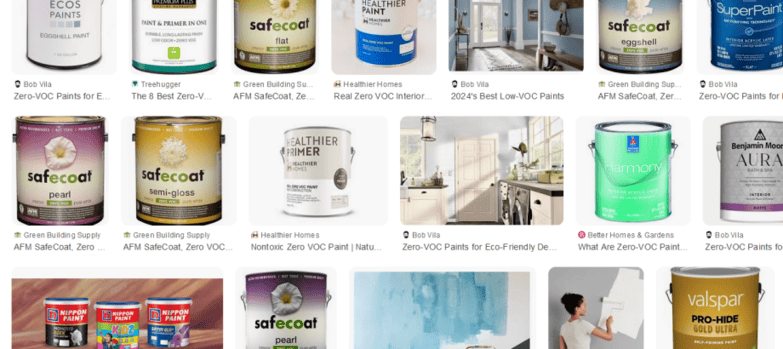Best Zero-VOC Paints for Interior Walls

When choosing a paint for your interior walls, consider zero-VOC options to improve indoor air quality, reduce allergens, and minimize environmental impact. Look for certifications like Greenguard Gold and CARB Compliance, and opt for brands that prioritize sustainable sourcing and natural resources. Top brands, such as Benjamin Moore’s Eco-Spec, Farrow & Ball, and Dunn-Edwards, offer a range of colors and finishes. To get the most out of your zero-VOC paint, select colors that promote your desired mood and complement your interior design. By exploring further, you’ll uncover more about the best colors, application techniques, and safety precautions.
Key Takeaways
- Look for certifications like Greenguard Gold and CARB Compliance when selecting zero-VOC paints for interior walls.
- Top brands for zero-VOC paints include Benjamin Moore’s Eco-Spec, Farrow & Ball, and Dunn-Edwards, offering a range of colors and finishes.
- Natural pigments from plants, minerals, or clay serve as healthier alternatives to synthetic pigments in zero-VOC paints.
- Consider color psychology and lighting conditions when choosing colors for interior walls to promote specific moods and ambiance.
Benefits of Zero-VOC Paints
Breathing easy in your newly painted home is a lot simpler when you choose zero-VOC paints, as they eliminate the risk of inhaling volatile organic compounds that can cause headaches, dizziness, and nausea.
By selecting these eco-friendly paints, you’re not only protecting your health but also contributing to a cleaner environment. The environmental impact of traditional paints can be significant, with VOCs contributing to air pollution and climate change.
Zero-VOC paints also improve indoor air quality, which is particularly essential in areas with limited ventilation. Plus, they offer long-term durability, resisting fading and cracking over time.
While you may be concerned about the higher upfront cost, consider the long-term benefits and potential cost savings. You won’t need to repaint as frequently, and you’ll reduce your exposure to hazardous chemicals.
When evaluating the cost considerations, weigh the benefits against the potential risks to your health and the environment. By choosing zero-VOC paints, you’re investing in a healthier, more sustainable home that benefits both you and the planet.
With these benefits in mind, making the switch to zero-VOC paints is an easy decision that’s better for everyone.
Top Brands for Zero-VOC Paints
If you’re ready to make the switch to a healthier painting option, several top brands offer high-quality zero-VOC paints that meet both your aesthetic and environmental needs.
You can find a range of color options and finish types from these brands, and it’s vital to compare them before making a decision. Look for brand comparisons to find the one that suits your needs.
Here are three top brands you can evaluate:
- Benjamin Moore’s Eco-Spec brand: Offers a wide range of colors and finish types, from flat to high-gloss.
- Farrow & Ball: Their zero-VOC line is available in numerous colors and has a distinctive high-end finish.
- Dunn-Edwards: Their line of zero-VOC paint is known for being easy to apply and offering a durable finish.
When assessing these brands, remember to reflect on the environmental impact of your choice. While all three brands offer zero-VOC options, their manufacturing processes and application techniques differ.
Reflect on these factors to guarantee you’re making a decision that aligns with your eco-friendly goals. By choosing a zero-VOC paint, you’re taking a significant step towards creating a healthier indoor environment while reducing your environmental footprint.
Eco-Friendly Paint Options
Several eco-friendly paint options are now available on the market, allowing you to make a more informed choice about the products you use to beautify and protect your home.
When shopping for eco-friendly paints, look for eco-friendly certifications, such as Greenguard Gold or California Air Resources Board (CARB) Compliant, which guarantee that the paint meets certain standards for indoor air quality. You can also opt for brands that prioritize sustainable sourcing, using natural resources responsibly. Some companies even offer paint recycling programs, allowing you to recycle leftover paint and reduce waste.
Furthermore, consider using natural pigments, which are derived from plants, minerals, or clay, and are a healthier alternative to synthetic pigments. These eco-friendly paints not only improve indoor air quality but also promote a healthier living space.
Best Colors for Interior Walls
You have a vast selection of colors to choose from regarding painting your interior walls, but selecting the right one can greatly impact the ambiance and aesthetic of your home.
Consider color psychology when making your selection, as different hues can evoke distinct emotions and moods. Currently, trending hues include calming shades of blue and green, which promote relaxation and serenity.
Here are some tips to keep in mind when choosing the best colors for interior walls:
- Consider Room Size: When painting a small room, opt for a lighter shade to create an illusion of a larger space. Dark colors can make a room appear smaller due to less light reflection.
- Think About Mood Improvement: Choose a color that will promote a specific mood or feeling. For instance, a soft yellow can elevate happiness and energy.
- Reflect on Lighting: Consider the amount of natural light a room receives when choosing a color. Lighter shades work well in rooms with ample natural light, while richer shades can create coziness in rooms with limited light.
Selecting the right color will result in a beautifully designed space that promotes your well-being and improves the overall atmosphere of your home.
Zero-VOC Paint Buying Guide
Now that you’ve selected a color that promotes your well-being, it’s time to contemplate the impact of paint fumes on your health and environment, which is where zero-VOC paints come into play. When buying zero-VOC paints, consider the following factors to guarantee a successful painting project.
| Factor | Description |
|---|---|
| Color Selection | Choose a color that complements your interior design and promotes your well-being. Consider the color’s LRV (Light Reflectance Value) and how it will affect the room’s ambiance. |
| Paint Finishes | Select a paint finish that suits your needs, such as flat, eggshell, satin, semi-gloss, or high-gloss. Consider the level of durability and shine you require. |
| Surface Preparation | Verify the surface is clean, dry, and free of old paint and imperfections. Sand and prime if necessary to create a smooth finish. |
Additionally, consider application techniques, such as rolling or brushing, and drying times to plan your project accordingly. By taking these factors into account, you’ll be able to choose the right zero-VOC paint for your interior walls and achieve a beautiful, healthy, and eco-friendly finish. Always follow the manufacturer’s instructions for the best results.
Safety Precautions to Take
Always handle zero-VOC paints with care, even though they’re considered a healthier option, as they can still cause skin irritation or allergic reactions in some individuals.
To guarantee your safety, take necessary precautions when working with these paints.
Ventilation importance can’t be overstated – make certain the area is well-ventilated to prevent inhaling fumes. Furthermore, don’t let children or pets nearby, as their sensitive skin and respiratory systems may be easily irritated. Keep in mind that children’s safety is essential, so have someone watch them in another room.
Here are three vital safety precautions to take when handling zero-VOC paints:
- Personal protective gear is a must: Wear old clothes, goggles, gloves, and masks to protect your skin and eyes from accidental splatters.
- Read the instructions: Understand the curing time required for the paint to dry completely, and avoid touching or handling the painted surface until then.
- Clean up carefully: Dispose of leftover paint and materials responsibly, and wash your hands thoroughly with soap and water.
Tips for Application Success
A successful application of zero-VOC paint depends on thorough surface preparation, so make sure the wall is clean, dry, and free of dust, dirt, or grease before applying the initial coat.
You’ll want to fix any holes or cracks with a patching compound and sand it smooth. This guarantees a strong bond between the paint and the wall.
Next, choose the right brush type for your specific paint and surface. Natural bristle brushes work well with oil-based paints, while synthetic brushes are better suited for water-based paints.
To achieve professional-looking results, master different application techniques, such as cross-hatching and feathering. Work in small sections, maintaining a ‘wet edge’ to prevent visible lines.
Don’t overload your brush or roller, as this can lead to drips and uneven coverage. Be mindful of drying times, allowing each coat to dry completely before applying the next.
Lastly, pay attention to color matching. If you’re painting over a dark color, you may need multiple coats to achieve the desired shade.
Frequently Asked Questions
Can Zero-Voc Paints Completely Eliminate Indoor Air Pollution?
You’ll find that zero-VOC paints can notably improve indoor air quality and offer numerous health benefits, but they can’t completely eliminate indoor air pollution; proper application techniques and regular maintenance are also essential.
Are Zero-Voc Paints More Prone to Mold and Mildew Growth?
You’ll notice that zero-VOC paints can be more prone to mold and mildew growth if the formulation doesn’t include mold-resistant additives; however, you can prevent this by controlling humidity and applying a surface treatment.
Can I Use Zero-Voc Paints on Exterior Walls as Well?
You can use zero-VOC paints on exterior walls, but consider factors like exterior durability, limited color options, and varying weather resistance; employing proper application techniques is essential for long-term performance in outdoor conditions.
Are Zero-Voc Paints Compatible With All Types of Surfaces?
You’ll need to contemplate surface preparation, paint adhesion, and application techniques when using zero-VOC paints, as they may not be compatible with all types of surfaces. You’ll also want to reflect on color selection and finish durability.
Do Zero-Voc Paints Have a Shorter Shelf Life Than Traditional Paints?
You’ll find that zero-VOC paints generally have a slightly shorter shelf life than traditional paints due to formulation differences, but proper storage conditions can help maintain their paint durability and performance comparison to traditional paints.
